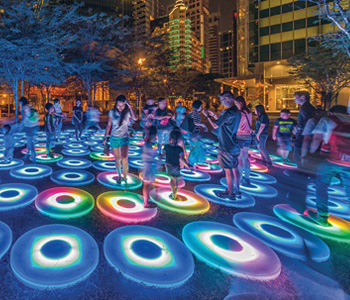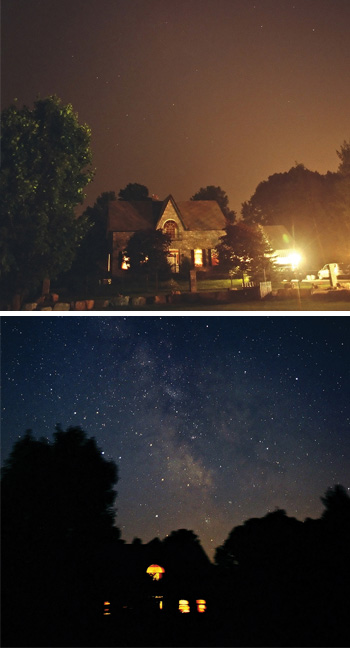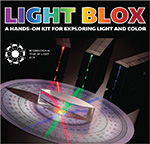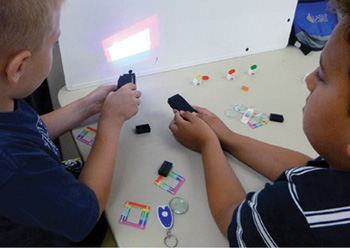 iLight Festival 2014, Singapore. Photo courtesy of Jen Lewin Studio, by Jeremy Hui.
iLight Festival 2014, Singapore. Photo courtesy of Jen Lewin Studio, by Jeremy Hui.
Light—the ethereal glow that inspires countless painters and poets, the first part of the electromagnetic spectrum that humans discovered—is about to take center stage.
The stroke of midnight on New Year’s Day 2015 heralds the opening of the International Year of Light and Light-Based Technologies (IYL), as officially proclaimed by the United Nations. IYL’s strongest supporters intend to make the notion of photonics as common as electronics has been to the public over the last half-century.
Since the invention of the laser, optical science has become “a solution to so many problems that we don’t even know exist yet,” says OSA Fellow John M. Dudley, professor at the University of Franche-Comté in Besaçon, France. Dudley heads the international steering committee that planned the yearlong festivities, and until April 2015 he serves as president of the European Physical Society (EPS). OSA and EPS are among the 12 founding partners for IYL, which also include the American Institute of Physics, the American Physical Society, Deutsche Physickalische Gesellschaft e.V., the International Centre for Theoretical Physics, SPIE, the IEEE Photonics Society, the Institute of Physics, Lightsources.org, Light Science & Applications, and 1001 Inventions.
“When people think about modern technology, they think about Bill Gates and Steve Jobs,” Dudley says. “These are wonderful innovators and giants, but they don’t think about Einstein or Charles Townes.”
Optical scientists have been almost too good at making photonics invisible and user-friendly, according to Dudley. Millions use video-chat services every day without appreciating the century of work—quantum mechanics, the laser, the development of optical fiber networks—underpinning the simple-to-use technology.
|
“Without Einstein, without Charles Townes, without the theory of the laser and its instrumentation, we wouldn’t have these technologies,” Dudley notes. Over the course of the next 12 months, he would like to make optical scientists as well-known as entrepreneurs and industry leaders.
An IYL timeline
Spring 2009: Germination of an idea
In 2009, Dudley represented EPS at the International Quantum Electronics Council meeting, held at CLEO in Baltimore (USA). After listening to OSA’s announcement of the LaserFest plans for 2010, the 50th anniversary of the first laser, Dudley voiced his immediate reaction: “Well, that’s great. What a shame we don’t have enough time to go to the U.N. and ask them to declare an international year of light.”
As Dudley recalls, his remark was followed by brief silence, then a discussion of what an “international year of light” would be about. OSA Fellow Robert Boyd, University of Rochester (USA), suggested that Dudley find out how to get an international year of light declared. “If you say things in meetings, then you may be asked to actually follow them up,” Dudley warns.
Two weeks later, at a conference at Singapore, Dudley chanced to meet the main organizer of the 2005 World Year of Physics, who explained the steps involved in working through the U.N. Educational, Scientific, and Cultural Organization (UNESCO) to gain endorsement of the yearlong commemoration.
2010 and 2011: Gathering the players
Dudley assembled an international steering committee of 12 scientists, including past OSA President Duncan Moore, to pursue the year of light. After obtaining endorsements from the executive boards of several major societies in optics and physics, the committee approached the International Union of Pure and Applied Physics (IUPAP), the international umbrella group that links all branches of physics. IUPAP had endorsed the World Year of Physics in 2005, and Dudley considered its backing crucial.
September 2011: Adding art and culture to the mix
Next, the steering committee approached UNESCO’s assistant director-general of science. In September 2011, the committee held a meeting in Italy, dubbed Passion for Light, at which scientists and UNESCO representatives shared the stage with an art historian who, according to Dudley, “convinced us that we should actually include art and culture more prominently and not just physics and science.”
|
Fall 2011 to 2013: Building global support
Two months later, IUPAP’s general assembly in London endorsed the IYL bid, with a special request to make sure Latin America and other Southern Hemisphere countries would be properly involved.
Over the next two years, Dudley and his steering committee worked on developing a political consensus behind their efforts. “It’s all very well for the scientific societies of the world to agree that something’s important, but we have no visibility at all politically,” he says. The IYL proponents had to learn how to approach the foreign ministries of governments around the world.
“Scientists are not naturally enthusiastic about approaching governments, and learning how to create a compelling political case for why the world needs to learn about light for an entire year was extremely difficult,” Dudley says. In the end, the team secured four sponsoring nations to place their resolution on UNESCO’s agenda: Ghana, Mexico, New Zealand (Dudley’s native country) and Russia. More than 30 other countries endorsed the measure.
In 2013, Dudley led a five-member delegation (including 2002 OSA President Anthony Johnson) to New York to explain to a U.N. subcommittee why light is important. He was apprehensive about approaching the subcommittee, saying “The United Nations has to address resolutions on world peace and wars and peacekeeping forces and treaties on the control of nuclear weapons, and here we are as a scientific community saying, ‘Well, let’s talk about light for a year.’”
20 December 2013: The U.N. endorses IYL
Ana Maria Cetto, research professor of physics at the National Autonomous University of Mexico (UNAM), notes that the U.N. endorsement of the IYL resolution was the first time the international body approved a commemorative year by acclamation rather than a vote.
Dudley points out that rich nations and developing countries need different things from optics and photonics, so the group has had to find common ground. “There’s a big difference, for example, between the problems that we have in rich countries, in terms of promoting optics and photonics, and the problems that they have in West Africa or in South America,” he says. In all its rich diversity, IYL will address those issues.
Improving the quality of life with light
Like many other United Nations-sponsored programs, IYL seeks to improve conditions in the developing world. Such changes can be as small as enabling a child to read books after sunset or as large as encouraging the growth of the African photonics industry.
More than 1.5 billion people have no electricity to power lights and cooking appliances in their homes. One of IYL’s programs, Study After Sunset, partners with a public-private initiative, the Global Off-Grid Lighting Association, to encourage the replacement of dim, dirty kerosene lamps with bright, solar-powered LED luminaires. “Most people just don’t appreciate the fact that when there’s no electricity, education is restricted to the hours of the day when there’s sunlight,” Dudley says. “The concept of homework, as we understand it, doesn’t exist.”
UNESCO strongly supports advanced education in Africa, and IYL is partnering with several African scientific organizations, including the African Laser, Atomic, Molecular and Optical Sciences Network; the African Physical Society; the African Spectral Imaging Network; South Africa’s Council for Scientific and Industrial Research; the African Laser Center; and the African Network for Solar Energy. The Cameroon Physical Society will host a conference on light sensors and transducers, and the Tunisian Optical Society will host a “Lighting UP Africa” training meeting in Carthage. In Mozambique, an educational group named KUGOMA will bring its mobile solar-powered film-screening equipment to children around the country.
Other IYL economic-development events include EcoLightTech Asia 2015, a lighting-technology trade show in Bangkok, Thailand; the International Conference on Optical Fibre Sensors, to be held for the first time in South America (Curitiba, Brazil); and an international gathering of scientists in Bogotá, Colombia.
The IYL website makes a strong case for the optics industry as a component of sustainable economic development. It links to a 2013 industry report by Photonics21, a European Technology Platform, and to the photonics projects sponsored by Horizon 2020, the European Union’s research and innovation initiative (see “Finding a Voice for Photonics,” OPN, September 2014, p. 26). The website also provides primers explaining lasers, optical fibers and solid-state lighting for anyone needing a quick explanation of their importance to society.
 View of the night sky from Goodwood, Ontario, before (top) and during a power outage (bottom). Courtesy of Todd Carlson
View of the night sky from Goodwood, Ontario, before (top) and during a power outage (bottom). Courtesy of Todd Carlson
Light pollution and the cosmos
Sometimes light is important not for its presence, but for its absence. Light pollution—that background sky glow that makes it impossible for billions of people to see the Milky Way at night—is a problem created entirely by humans, though it also affects birds, sea turtles and other nocturnal creatures (OPN, July/August 2012, p. 30).
The international Globe at Night program, a citizen-science project to improve awareness of light pollution by getting people to look up at their night skies, has populated the IYL master calendar with the dates for its 2015 observing campaigns. During each campaign, participants gaze up at the designated constellation, count the stars they see and report that number to Globe at Night. Project officials tally the data by location and use them to track changes in night-sky brightness since the program began in 2006. Globe at Night’s observing campaigns occur when the moon is waning in the sky.
The IYL website links to the International Dark-Sky Association and Dark Skies Awareness, two organizations that publicize the light-pollution problem and promote energy-efficient outdoor lighting practices.
Of course, the light that comes from the night sky has great potential to engage and excite people around the world. Through the International Astronomical Union (IAU), the Cosmic Light theme of IYL will bring stunning astronomical photographs to the public and will highlight the importance of imaging to the study of the universe.
Women and education in optics
Many nations express concern that fewer women than men pursue careers in science and engineering disciplines. The IYL team wants to improve this gender balance, and several programs reaching out to female students are already on the calendar. For example, the GoPhoton! program of the European Centres for Outreach in Photonics (ECOP) will hold a “Girls, Boys and Photonics” event for secondary-school students in February. (For more on GoPhoton!, see “Conversations,” p. 20.)
Other IYL programs will attempt to educate the whole family. Grand Valley State University (Michigan, USA) will host the all-ages-friendly “Super Science Saturday: The Wonder of Light” this month. National Cheng-Kung University (Taiwan) is offering an optoelectronics camp that will teach through games. The library of Birmingham, England, will set aside one day in September for exhibits and demonstrations on the importance of photonics to everyday life.
UNAM’s Ana Maria Cetto played a large role in the development of Mexico City’s 19-year-old Museo de la Luz (Museum of Light). Currently she is working on a major renovation of the museum’s exhibit space, which she hopes will reopen later this year as part of the IYL.
Since 2015 marks the millennium of one of the most important works of medieval Arabic science, Ibn al-Haytham’s Book of Optics, Dudley says that the IYL celebration will include several events in the Middle East to encourage the youth of these countries to study science and learn about the potential of photonics to improve the quality of their lives.

For individual classroom teachers, the IYL team designed a “Light BLOX” activity package with battery-powered LEDs, lenses, a diffraction grating and other accessories. The official website also links to OSA’s Optics Suitcase and other educational kits.
“The story of light is so attractive that children of all ages get very drawn into science and academics through light,” Dudley says. No matter what career youngsters eventually choose, light and its mysterious properties provide a powerful, captivating gateway into scientific inquiry.
 IYL light education kit. The OSA Foundation launched a campaign to raise funds and distribute thousands of Light BLOX education kits to students in celebration of the 2015 International Year of Light. The kit provides hands-on activities that introduce students to the science of light, as well as a guidebook with lesson plans and activities. Find out more at www.osa.org/iylkit.
IYL light education kit. The OSA Foundation launched a campaign to raise funds and distribute thousands of Light BLOX education kits to students in celebration of the 2015 International Year of Light. The kit provides hands-on activities that introduce students to the science of light, as well as a guidebook with lesson plans and activities. Find out more at www.osa.org/iylkit.
Light, art and culture
Dudley admits that he initially felt hesitant when UNESCO insisted that IYL include artistic and cultural programs, because they might complicate the planning effort. “But when I saw that people were organizing these things on their own, I thought, ‘Why not?’ Who are we to impose any sort of control over this?” he says.
Answering UNESCO’s concern for the social and cultural aspects of optics, IYL will feature artistic festivals of light on multiple continents. The IYL kickoff will be held in Paris—La Ville-Lumière (the City of Light)—on 19 and 20 January. OSA is sending a delegation of 20 volunteers and staff to the event. “This event is about more than just one weekend” said OSA CEO Elizabeth Rogan. “It’s about an entire year—one that celebrates how modern light-based technologies fill every corner of human existence, from the home to the laboratory to the street to outer space.” That light, she added, “extends far beyond the United States and Europe; it shines in remote rural communities in Asia, Sub-Saharan Africa and throughout the developing world. That’s also what IYL is about.”
Some IYL events, such as the SIGNAL Festival in Prague, Czech Republic, happen annually but are listing themselves on IYL’s master calendar to join in the celebration. The mid-October festival attracts artists who work with light-based technologies to illuminate historic downtown facades with ever-changing colors and patterns and to build interactive, kinetic experiments with light and sounds.
On the other hand, the Great Britain-based Society of Glass Technology has scheduled a conference, “Glass Reflections: Glass in the Year of Light,” which will explore both scientific and artistic aspects of its subject. The society has not yet announced the meeting program, scheduled for September, but its website promises session tracks in glass science, glass art, archaeology, history and the conservation of important glass artifacts.
In preparation for IYL, communications and science students at the University of Applied Sciences Offenburg in southwestern Germany collaborated on a series of posters illustrating the celebration’s underlying concepts in creative ways. Guiding the project was Dan Curticapean, an optical physicist who works as a media technology professor at Offenburg and once won OPN’s annual photo contest. Some of the communications students made a few scientific mistakes with their early designs, which they subsequently corrected, but Curticapean says that’s all part of the learning process; in their future marketing careers, they will undoubtedly need to work with people from other fields. “Good projects appear when people are working in different areas,” he says.
Anticipating a great year
As the months of 2015 unfold, many more events will undoubtedly be added to the IYL calendar. “The growth of this enthusiasm worldwide has been driven very much by the community in a bottom-up way,” Dudley says. “It sometimes seems totally anarchic in the way it’s developing. But it’s not anarchy at all—it’s just spontaneous.”
Six years ago, activities associated with the International Year of Astronomy reached an estimated 800 million people, Dudley says. He hopes to top that number with IYL—to connect in some way with at least one billion persons all over the world, through public festivals and educational efforts both great and small.
According to Dudley, the IYL steering committee hopes not just to influence residents of the world’s richer nations to study science, but also to encourage governments of the poorer countries to invest in science education. “Whether they invest in chemistry or physics or optics or mathematics, at the end of 2015 it doesn’t matter,” he says. “But we have to raise the profile of science. Light is a great vehicle to do that.”
In 1917, Albert Einstein remarked, “For the rest of my life, I will reflect on what light is.” If Dudley and his collaborators have their way, by this time next year, a billion people on this planet will similarly marvel at the wonders of light—and the myriad ways it could improve our world.
Patricia Daukantas is a freelance writer specializing in optics and photonics.
